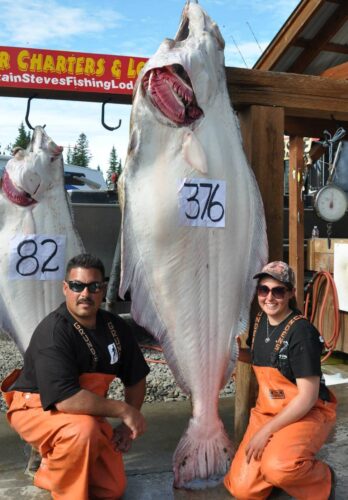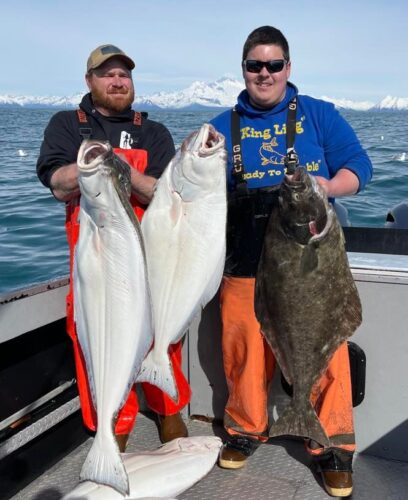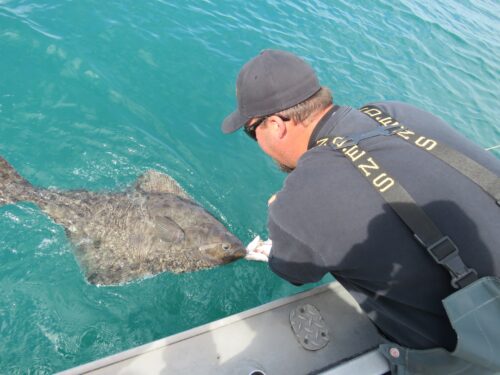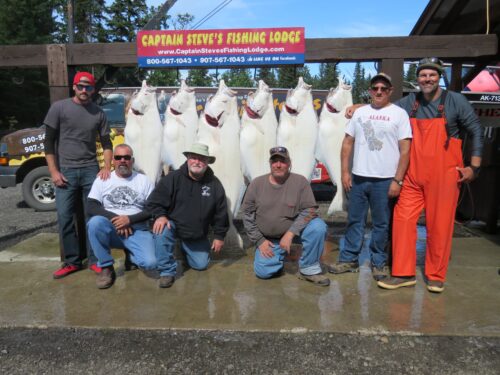
Alaska Offers A Helluva Halibut Experience
The following appears in the May issue of Alaska Sporting Journal:

BY CAL KELLOGG
I consider the Pacific halibut to be Alaska’s premier saltwater gamefish, and my assertion is doubly true for anglers fishing off the Kenai Peninsula, since it borders the rich halibut waters of the Cook Inlet. That’s a bold statement when you consider the popularity of salmon fishing, but I can back it up.
I’ve spent a lot of time fishing Alaska’s Kenai, and over the years I’ve introduced dozens of anglers to the Alaskan saltwater fishing scene. To be sure, there is no species of fish that gets first-time Alaskan anglers as excited as salmon.
Two of the most frequently asked questions I’d get from saltwater anglers accompanying me to the 49th state were 1) whether we’d be getting salmon, and 2) if they could expect to get limits of salmon every day. My answer was always the same: “Maybe; maybe not.”
That’s because saltwater salmon fishing Alaska is a lot like targeting them in other places. When the fish are there, you hammer them. When they aren’t around, you won’t catch any.
I was on a six-pack boat fishing just outside Cook Inlet a few seasons ago when we spotted a surface boil of silver salmon and black rockfish. We put full limits of salmon and quite a few big blacks into the boat in 18 minutes while tossing simple metal jigs. In contrast, I’ve been on weeklong trips at the same time of the year and never saw a king or silver. Salmon fishing along the Kenai Peninsula is a crapshoot.
When it comes to Kenai halibut fishing, chance isn’t part of the equation.
If the conditions are calm enough for safe navigation inside the Cook Inlet, which is typically the case, limits are the rule. And these fish generally run big, bigger and downright massive. A decent keeper is about 30 pounds, and 100-pound “barn doors” are common, plus huge fish weighing well over 300 pounds are caught every season.


ENJOY A GREAT MEAL
As exciting as catching Pacific halibut can be, eating the snow-white halibut meat is just as rewarding. Plus, vacuum-packed Alaskan halibut meat is the gift that keeps on giving because it keeps so well.
The longer you keep salmon frozen, the stronger and fishier the flesh becomes. This isn’t the case with halibut. I’ve kept halibut in the freezer for up to three years and found it to still be quite good!
If you’re interested in packing the freezer, halibut are the fish that make it happen. Lingcod, rockfish and salmon filets are nice additions to the boxes of frozen fish you bring back from Alaska, but make no mistake, halibut are the kings of the show. Vacuum-sealed bags of halibut stack up quickly when you consistently score your two-fish daily limit.
Halibut are meat-heavy with relatively small organs and a small head. Each fish produces four thick filets. A “small” 30-pounder will fill several 1-pound bags, while “good fish” in the 60- to 80-pound class can provide the centerpiece for dozens of memorable meals.
Let’s look at what a Kenai Peninsula halibut adventure entails!
WHAT TO WEAR AND BRING
When fishing for halibut along the Kenai Peninsula, chances are you’ll be fishing inside Cook Inlet. Halibut caught outside the inlet are typically landed while targeting lingcod around reefs in the Gulf of Alaska.
Traditional halibut season runs from May through early September. Most of the time the Cook Inlet is calm and sea sickness isn’t a huge concern, but occasionally there are days when it’s choppy, with 4- to 6-foot wind waves. These conditions are fishable, but can be challenging for anglers without much saltwater experience.
Cook Inlet features traditional marine weather, where you’ll be fishing under overcast skies more often than you’ll experience sunny conditions. Rain is always a possibility in Alaska, but most of the time it’s nothing more than a light drizzle.
A halibut boat is a wet, slippery place, so you’ll want to dress accordingly. Rain gear is a must, as are rubber boots. You should wear layers under the rain gear because you’ll get warm working the gear and fighting fish. Invest in a form-fitting high-tech wicking base layer and thank me later. The tight fit makes you feel like a superhero and the wicking properties ensure you’ll never have to endure feeling steamed up or clammy.
Make sure your rain gear features a waterproof hood. Headwear is a consideration you don’t want to overlook. I’ve always found beanies better suited for Alaskan fishing than ballcaps. Beanies work well under a rain hood, and they can be pulled down to keep your ears warm.
Finally, you’ll want a medium-sized waterproof bag for personal items like cameras, gloves, wallet, phone, snacks and such. I prefer backpacks for this work, since they free up my hands when boarding and disembarking from the boat.

BOARDING, BEACHING THE BOATS
And this brings us to the boats. Most Cook Inlet halibut fishing is done from aluminum-hulled cabin boats that are capable of carrying six anglers, plus a captain and a deckhand. Unless you’re fishing out of Homer, where boats are moored in slips, you’ll likely be launching off a beach. This is quite a thrill and something you won’t soon forget.
When you get to the launch, a ladder or portable stairway will be set up and you’ll climb aboard the boat while it’s still on the trailer. Anglers stow their gear and take a seat in the cabin, the captain jumps behind the wheel and the deckhand is stationed on the back deck.
The boat trailer is connected to a big tractor and the boat is towed across the sand and backed into the water until the water is deep enough for the boat to back off the trailer.
Launching is cool; landing is even more exciting. On the way in, the skipper radios the landing and the trailer is backed into the water with a tender dressed in rain gear standing on the trailer’s tongue. The captain deftly drives the boat onto the trailer at a brisk clip, the tender hooks the keeper cable to the front of the boat and the trailer hauls the boat back up to the parking lot.
Most boats launching off the beach are serious fishing vessels hunting for big fish. These crews release small fish and try to get the biggest fish possible for their clients. Down in Homer, some of the slip boats are serious big-fish boats, but there are also tourist boats. These operators want to run up to two trips per day. They take anglers out to the nearest halibut concentration, and every keeper coming over the rail goes into the box. As a result, most of the fish harvested on these boats are on the small side.

TALKING ’BUTS
Let’s talk about halibut. Cook Inlet is literally paved with halibut of all sizes. When fishing for them you’ll get hit continuously. The more hits you get and the more fish you hook, the more intense the bite becomes because the scent and sound created draws fish in from a distance.
Tides are an important ingredient to optimum results, and here’s why: The Cook Inlet’s halibut grounds are subject to massive tidal changes. The amount of vertical water movement can range from 10 to 20 feet. Days with a lot of vertical movement are days with strong currents, and this limits fishing depth. Days with a small amount of tidal movement translate to gentle currents (by Alaskan standards) and allow boats to anchor on deep-water pinnacles. Since these deep-water spots can only be fished during days with small tides, they don’t get much pressure. These are the spots where you stand the best chance of hooking into a true monster halibut.
This isn’t to say that you can’t hook big fish in shallow water. On one of my hosted trips, a man nailed a 181-pound halibut while fishing just 30 feet deep. However, if your goal is getting a crack at something over 100 pounds, make sure you book your trip at a time with average or less than average tidal movement. Tide predictions are available online.
THE FISHING EXPERIENCE
Halibut are so thick in the Cook Inlet, you can catch them on artificial jigs. My first Alaskan halibut I ever caught was hooked working a Gibbs Minnow metal jig for silver salmon. The fish put up a massive fight on light gear. When I got it to the surface, Capt. Steve Smith of Captain Steve’s Fishing Lodge (captainstevesfishinglodge.com) lifted it aboard, unhooked it and tossed it back.
“Too small,” he said as I watched the 35-pounder rocket away. I was stunned. Having fished for halibut in California my entire life, it was the biggest halibut I’d ever landed by a wide margin.
When you’re anchored at the halibut grounds, the deckhand and skipper might toss out a 1-pound leadhead jig with a huge white grub pinned on it. They’ll bounce the jig on the bottom; if they hook up, they’ll pass the rod off to the nearest angler. The clients on the boat will be fishing with bait. Every boat runs the gear a little differently, but I’ll describe the basics so you’ll know what to expect.
Three anglers fish from either side of the boat. The angler dropping down takes up a position nearest the cabin. When the angler in front of you reels in a fish or reels up for new bait, everyone moves down one spot toward the rear of the boat. This rotation keeps lines from getting tangled.
You’ll be using stout gear that’s spooled with 120-pound-test braided line. The final 20 feet of the line will be doubled. Big Pacific halibut are extremely strong and capable of lightning-fast bursts of speed. End tackle consists of a 2- to 4-pound sinker rigged to slide and a paracord leader armed with a pair of massive circle hooks. These hooks pin every fish in the corner of the mouth, allowing small fish to be released unharmed.
Chunks of herring are the most common halibut bait, but if salmon are around most skippers will bring some salmon heads along to use during prime bite windows. Salmon heads have a reputation for producing massive halibut, but there is a downside. They are also very attractive to the huge skates that call the Cook Inlet home. You haven’t lived until you’ve cranked a 100-pound skate up from 200 feet deep as it glides and bulldogs using the current as leverage. Take it from me: It’s a muscle-burning experience.

WHEN YOU HOOK UP
Proper execution is an important part of success and it’s something I’ve never seen described in print, so here goes. You’ll be standing at the rail with the butt of the rod wedged against your hip. Yes, you’ll have a bruise there by the time you’re done. With your strong hand on the rod grip in front of the reel, you’ll lift the sinker off the bottom about every 30 seconds and set it back down. This movement attracts halibut and discourages the aforementioned skates.
A halibut bite starts with a series of taps. At this point the rod tip must be held still and your weaker hand moved to the reel, ready to retrieve line. You can’t set a circle hook with a traditional hookset. You’ve got to reel the hook into position in the halibut’s mouth.
Gradually, the taps and tugs get stronger. The firmer the tugs, the bigger the fish. When the rod tip starts to draw down hard, start cranking the reel smoothly. If you execute the routine correctly, you’ll be locked up with the fish.
The harder you fight the fish, the harder they’ll fight you, so you’ll just want to grind on the reel smoothly and keep the rod tip loaded against the fish. If slack develops, the halibut will execute some ribbon-like full-body gyrations and, often as not, they will toss the hook.

THE SLACK MENTALITY
Here’s a final piece of strategy you should really take to heart. I’ve seen more big halibut lost than landed and all of them gained back their freedom due to the angler giving them slack line.
When the current is moving, the current helps keep the line tight. Typically, you’ll anchor when the tide is moving and fish until it goes slack. When the tide is going slack, you have your best chance of hooking a truly big halibut, but you won’t be able to rely on the current to aid in keeping the line tight.
By the time the current backs off you’ll have been battling halibut, skates, sharks and perhaps the odd Pacific cod for 90 minutes to two hours. When the prime bite window arrives, your arms are already as limp as a piece of licorice resting on the dashboard of a car on a sunny day. This is when you’ve got to suck it up and take the pain.
You’ll get from two to six opportunities when the tide is slow or slack, and it is absolutely critical to convert these bites into hookups and convert those hookups into landed fish.
Pace yourself when the current is ripping and never give an inch of slack when the current is placid. When I sense the current weakening, I gobble down a chocolate bar to spike my energy level.
If you don’t work out, consider putting in a few months of work at the gym prior to your trip. Good endurance, a strong core and good shoulder strength will allow you to punish the halibut instead of them punishing you.
When your 100-plus-pound barn door hits the deck, you’ll forget all about the burn. And you’ll be part of a special fraternity made up of halibut anglers who’ve landed 100-plus-pounders! ASJ
Editor’s note: Cal Kellogg is a longtime California-based outdoors writer. Subscribe to his YouTube channel Fish Hunt Shoot Productions at youtube.com/ user/KelloggOutdoors



